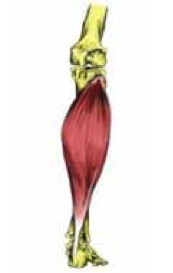Image taken
from Google photo bucket.
A
muscle cramp is an uncontrollable twitch or painful spasm that results in
an involuntary contraction of a muscle that does not relax.
- Leg cramps (hamstrings)
- Calf cramps
- Foot cramps
- Hand cramps
- Muscles that are commonly used repetitively over a period of time are more prone to cramp.
- Muscle cramps can also occur in other muscles.
Causes of muscle cramps
Exact cause of muscle cramps has not yet been successfully determined.
But are thought to be a number of possible causes which are the following;
Dehydration are caused by not drinking enough water, especially in hot conditions.
Low potassium or sodium (salt) levels. When we sweat we lose salts in which need to be replaced. Most people will usually take on enough salt in their diet for this not to be a factor, however if you are exercising in the heat for a couple of hours or more then an energy drink with electrolytes might be a good idea.
Image taken from Google photo
bucket.
Tight muscles restricted the blood flow and nutrients which will affect the muscle to work efficiently.
Image taken from Google photo
bucket.
It is essential to have sports massage treatment to restore the muscle to its original condition.
There are many different reasons
why you could be getting muscle cramps. It could be most likely a combination
of a number of factors including:
- Electrolyte and mineral imbalance
- Tight and inflexible muscles
- Muscle injury
- Muscle fatigue
- Physical overexertion
- Reduced blood supply
- Excessive perspiration or sweating
- Dehydration
- Inadequate diet
- Illness and/or medical disorders
- Poor physical condition
- Constrictive clothing or footwear
- Being in a fixed position for too long
- Vitamin deficiencies – Particularly a shortage of B1, B5, B6 and D
- As we age or muscle naturally become less flexible
- Some medications and alcohol
Muscle cramp
prevention strategies
You could prevent muscle cramps by:
- Adequate nutrition - Right balance of electrolytes and nutrients
- Regularly stretching
- Warming up and cooling down before and after physical activity
- Drink plenty of water before, during and after exercise
- Make sure you are physically fit for the activity you are undertaking
- Regular massage can help reduce muscle tension
- Attention to safety and ergonomic factors
- Stay cool – During a heat wave, go and seek a cool location and refrain from strenuous activity outdoors during the hottest times of day.
- Eat a banana – Bananas are loaded with potassium, and can give the body enough potassium to counter what is lost during perspiration.
- Stretching – Stretching the legs and feet prior to, and after physical activity lengthens and bathes the muscles with oxygen-rich blood. This circulation enhancement method provides substantial fluids which can prevent cramping.
- Low in salt in your diet can cause cramp, however there is so much salt in processed foods in the western worlds diets that lack of salt is an unlikely
If
you are prone to easily experience muscle cramps during a bodywork session. A
therapist can help its dissipation with the following methods:
- Massage – Massaging the cramped muscle increases circulation in the tissue, providing a rush of new fluid to bathe and relax the tense muscle. Sport massage and myofascial release techniques are particularly effective.
- Hot Pack Application – While not hot enough to cause perspiration, the radiance of a hot pack applied to a cramping muscle can enhance circulation. In addition to potentially alleviating the cramp, this technique is particularly soothing.
- Icepack - With severe cramp an icepack applied to the muscle for a few minutes may help the muscle to relax
- Medication - See your doctor if you experience regular muscle cramps over a period of time.
Sports Massage and Cramp Muscles
Sport massage techniques
will improve the condition of the muscles by helping tight or knotted areas
relax.
A sport therapist can advise on
stretching and strengthening to help prevent future bouts of cramp.
When the muscle cramp and it goes into spasm, the spasm squeezes the blood out of the muscle like a sponge preventing the muscle from getting its much-needed nutrients. And if the spasm is severe then there may be damage to the muscle (a muscle strain).
Massage must not be performed during the acute stage of this injury which is usually 48 hours after injury. This is because if there is still bleeding then heat and massage will increase bleeding, not stop it.
This article is brought to you by Precision Massage Clinic located in Bankstown and written by Jade Tran (Sport Massage Therapist, Remedial Therapist, Myofascial and Craniosacral Therapist and Cupping).





Comments